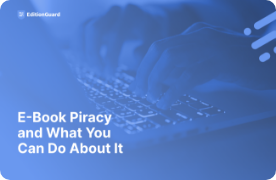Online Piracy Is Rampant, but There Are Legal Protections for Content Creators
The Internet is an incredibly powerful tool for sharing ideas and selling content. Unfortunately, it’s also a superhighway for selling or sharing pirated intellectual property. A quick Google search will uncover pirated films, music, and e-books that are often free for download. In addition, searching for pirated versions of your own content can be difficult because more advanced groups hide behind closed forums. There are legal mechanisms to compel website hosts to take down pirated content, but in practice, these remedies take time and money to resolve. This article will examine how to search for pirated content and what to do once you find it online.(Source: Adobe)
How Piracy Impacts Content Creators
According to one study, online piracy of e-books costs publishers over $300 million each year. That study reveals that the people who illegally download e-books are as diverse as the titles they read. They range from college students to working professionals and use a variety of tools to download and store pirated content. Online piracy worldwide is at record highs, and sites hosting pirated content received 300 billion visits in 2017. The United States had the largest population of residents illegally downloading content, followed by Russia and India. Most visits were to streaming sites followed by torrent sites and direct download portals, which are more commonly used for pirated e-books. The unfortunate truth is that pirated content is easy to find online and there is no shortage of people willing to download content without paying for it. While there is legislation in place to protect content creators, digital pirates are much more nimble and are often one step ahead. One of the first lines of defense to protect content is effective DRM software.DRM Software Protects Digital IP
Digital Rights Management software protects files from piracy. DRM varies depending on the type of content but encryption—along with passwords and digital watermarks—is the most common form of piracy prevention for e-books. The appropriate level of protection varies depending on the material; an academic paper containing sensitive or proprietary information may need more protection than an e-book written by a first-time author. The challenge with DRM is balancing protection versus ease of use. Readers increasingly demand that they be able to access content anytime, anywhere, on any device. Security solutions need to protect IP without negatively impacting the reading experience.What Is Adobe DRM And How Does It Work?
Adobe DRM adopts this mindset and achieves a balance between security and convenience. Adobe’s DRM software is built on the industry-standard Adobe Content Server, which provides content creators and publishers a platform to securely distribute and monetize e-books. To protect IP, customers are issued a unique customized ID that is required to access authorized content, and publishers can make content available to specific customers for a predetermined window of time. E-books secured by Adobe DRM can’t be copied or shared. Ensuring that Adobe DRM encryption remains one step ahead of would-be hackers and pirates requires constant vigilance and investment. Perhaps for this reason, the high costs and technical know-how required to deploy Adobe Content Server and DRM protection put it out of the reach of many content owners. EditionGuard eliminates these barriers and makes Adobe DRM affordable to both small and established firms. Clients pay one low monthly fee to get industry-leading content protection standards, rather than paying significant upfront installation and maintenance costs. EditonGuard allows creators and publishers to focus on producing great content without worrying about the technical requirements necessary to protect that content online.Adobe DRM Alternatives
Aside from Adobe DRM protection for e-books, there are a number of other strategies to protect digital IP. Password protection and social DRM/watermarking can be useful but have significant drawbacks that we will explore in more detail.Password Protection
Password protection is the simplest and easiest to use method for protecting digital IP. Adobe Acrobat and Preview for Mac both offer built-in password protection options. However, this simple solution provides no flexibility. Password protection is absolute—you either have the password or you don’t—and doesn’t offer tiered access. Password protection also can be easily defeated using online tools that can be low-cost or free.Digital Watermarking for E-Books
Social DRM is particularly prevalent in Europe and involves imprinting files with a “payload” of hidden or visible information that identifies the purchaser of the content. That payload might be the full name or account number unique to the buyer. The actual watermark might be embedded in images or as a header/footer on each page depending on the algorithm. Some watermarking algorithms seek to deter theft by including the owner's name or personal information in the document; in theory, this discourages theft because the owner will be less willing to share materials that identify them as the source of unauthorized copying or distribution. Hidden watermarks are geared less towards immediately deterring piracy and more toward prosecuting or otherwise punishing offenders after the fact. Encryption-based DRM is sometimes confused with watermarking, but they are fundamentally different protection mechanisms. DRM limits the ability of the user to access content outside of approved apps or devices; watermark algorithms are device or app-agnostic. (Source: Adobe)
(Source: Adobe)
Legal Protections for IP
E-books and other published content are protected under U.S. law as well as international statutes. There are different overlapping protections that you need to understand in order to protect your IP online: Copyrights: Copyrights protect original works of authorship from theft or misuse and are registered with the U.S. Copyright Office. This legal protection grants the owner exclusive rights to publish, reproduce or distribute the IP. “Authorship” broadly includes books, software, film, paintings, and even live performances. Copyrights typically last as long as the lifetime of the owner plus an additional 70 years. The owner of the copyright has the power to permanently or temporarily transfer ownership to another party. Trademarks: A trademark is a word, phrase, symbol, or design distinguishing the origin of one party’s goods versus those of another party. Trademarks typically include logos, brand names, and slogans. Unlike copyrights, trademarks do not expire after a set period of time, and in theory, a trademark lasts as long as the owner continues to use it consistently. Trademarks don’t need to be registered, though doing so notifies the public of the registrant’s claim and creates a legal presumption of nationwide ownership. Digital Millennium Copyright Act (DMCA): Signed into law in 1998, the DMCA provides explicit protections for copyrighted material on digital platforms. In addition, DMCA prohibits circumvention of online anti-piracy software and makes it illegal to create or share tools used for that express purpose. DMCA also provides a mechanism for companies to issue a “takedown request” when they find pirated material online. Let’s explore that process in more detail.How a DMCA Takedown Request Works
A DMCA takedown notice allows content creators or publishers to request that an ISP, web host, or other web manager removed copyrighted material. In order to initiate a DMCA request, the content creator or publisher must identify the pirated content and prove ownership. It’s advisable to take time-stamped screenshots of the pirated content to preserve evidence. The request is then sent to the service provider’s DMCA agent, which all providers must appoint and register with the U.S. Copyright Office. However, several different types of online service providers are protected from this law and usually aren’t liable for DMCA violations:- Conduits: Services such as broadband access providers who may have pirated material passing through their networks.
- Caching Services: Services that temporarily cache data, such as those used by many broadband providers.
- Information Location Tools: Search engines or directories are protected provided they don’t encourage or profit from infringement.

(Source: Adobe)



